
Free download earnmoney - can look
Free download earnmoney - there
How Do Free Apps Make Money in 2020? – 11 Proven Strategies
How do free apps make money in 2020? Ever thought how to make money from free apps? This article is for entrepreneurs who want to learn – how to create and monetize an app or make money with apps to earn passive income by publishing free apps in the mobile application market.
Introduction
As free apps market have always outnumbered the paid ones (in terms of profits and download numbers), most of the people often ask a common question that – how much money do apps make. Ever thought how to make money from apps?
Before we answer that question on how free apps make money, the first thing you need to know is that the app boom hasn’t ended (and it won’t), according to Techcrunch.
Even though the percentage of paid app revenues has decreased to 37.8 % from 75.9%, the mobile application market is still worth billions of dollars.
Free and Paid Apps Download Statistics
In fact, here’s an interesting graph that shows the difference between a number of paid apps downloads vs. free apps downloads:
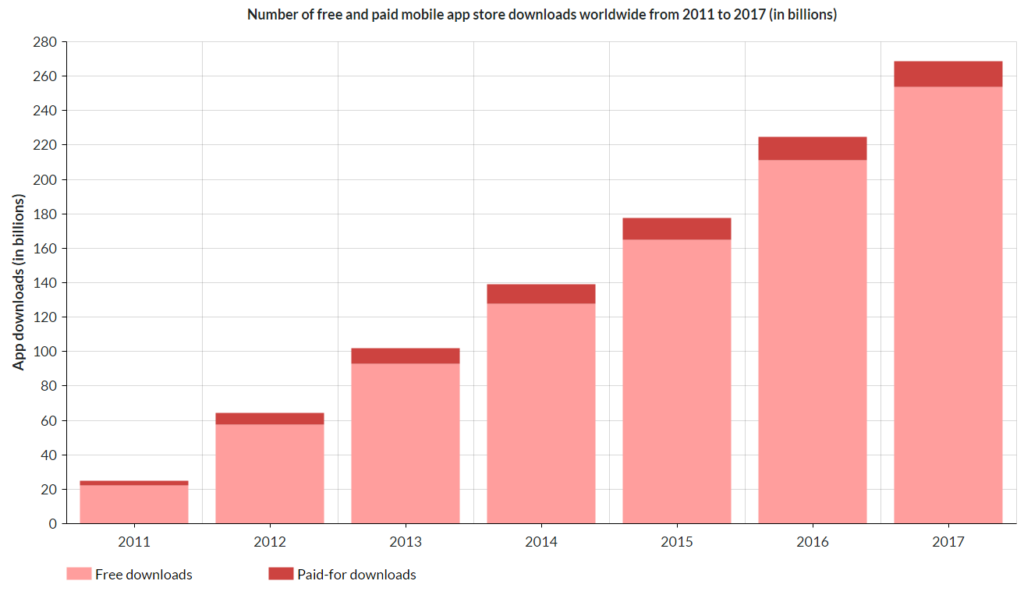
The experts also predict that, between 2016-2020, global app revenue will double!
So if you think that free mobile apps are not as profitable as much as the paid ones, then you couldn’t be more wrong. The fact is, 98% of worldwide revenue comes from free apps, according to Google Play. And, you need to think more about app monetization strategy.
Want to Create an App and Earn Passive Income?
Validate your app idea. Get free consultation from app development experts.
Techcrunch also says that more than 90 percent of apps on the market now are free. And, the revenues generated from apps that charge for download (paid apps) are expected to go down in upcoming years.
Now if you want to learn how to monetize your app without an ad or how do apps make money, then you’ve come to the right place.
We’ve already worked with many Entrepreneurs over the years of our journey and helped them convert their ideas into the best money making apps.
In fact, our clients admire the expertise we’ve on photo and video app development. And because of that, we’ve been able to build apps that make you money, and can generate a good amount of revenue for our clients but also got ranked on the list of top photos videos apps category.
If you would like to learn more about these top photos videos apps developed by us, then visit our portfolio section.
App Monetization Options
According to Statista, these were the most popular app monetization methods used by top app publishers.

Another recent statistics researched by our app consultants clearly shows a win-win scope for the free apps. According to Statista, the distribution of free or paid apps in the Apple store and Google Play store as of December 2019 is mentioned as below as per the users.

After looking at these statistics of the apps stores, if you are wondering about the major difference between the free and paid apps. Herein, we have narrowed down a gist for you.
Difference Between Free Apps and Paid Apps
| Free apps | Paid Apps |
|---|---|
|
|
Ok, so you can clearly see that there’s a lot of different ways to make money with app development, but which are the top options here? How do people make money from free apps in these ways?
In a nutshell, free apps make money using one of these 11 app monetization strategy: Advertising, Subscriptions, Selling Merchandise, In-App Purchases, Sponsorship, Referral Marketing, Collecting and Selling Data, Freemium Upsell, Physical Purchases, Transaction Fees, and Crowdfunding. Let’s analyze the top and most popular revenue models of how to make money on free apps.
11 Most Popular Revenue Models for How Do Free Apps Make Money
Advertising
Advertising is probably the most common and easiest to implement when it comes to free app makes money. And it is also done via a third-party ad network.
According to the latest report and study by Statista, here are the details on mobile advertising spending in the year 2019 and expected in 2020.
Year 2019: 190 billion U.S. dollars
Expected in 2020: 280 billion dollarsUsing ads to monetize apps and make money is quite simple. An app owner just needs to display commercials inside their mobile application or opt for affiliate marketing and get paid from the third-party ad networks.
You can get paid every time an ad is displayed (per impression), per click on the ad, and when a user installs the advertised app. Being a free version app, you can also run ad campaigns to generate ad revenue for a specific period of time.
There are mainly 4 types of display ads that are displayed by the app providers for monetization. But, as an app owner, you need to monitor whether the targeted users are finding these ads entertaining or are they ad blocking them.
Interstitial ads:

This type of app advertisements is full-screen pop-ups that are displayed at specific time frames. Users can close this ad by a close button at the upper left or right corner.
For example, an ad can be displayed when a user finishes editing a photo and saves it in the gallery.
This method is used by Gaana, which is a great example of app monetization. This app by integrating such ad tactic without any advertising fees has managed to enhance its app experience.
Banner ads:

These display ads are displayed in different sizes and at the top or bottom parts of the app screen. They are often small and less obstructive which helps users to freely use the app.
In-app video ads:
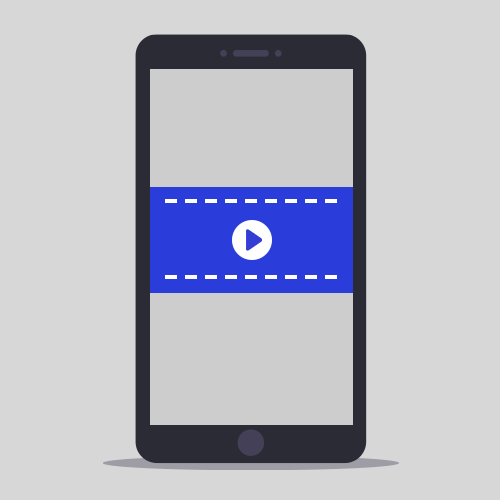
These ads are displayed automatically and generally used as a reward video in exchange of some in-app rewards. For example, by watching the ad video, the app users can get the app currency which can be useful for either unlocking levels in the game or getting additional features. This is the popular ad revenue model among users.
Native ads:

Native ads are integrated to appear as a natural element in the app. Most of the time, it is manifested to promote a product or a mobile app. In this case affiliate marketing will help in user engagement for your app for free.
This method is getting more and more popular these days because the users are less irritated and intrusive with such ads.
However, one point that you need to know about native ads is that their revenue can be pretty low compared to other methods. And despite the mobile app developers think of native ads as the best strategy, it is the most hated by users.
Rewarded Videos:
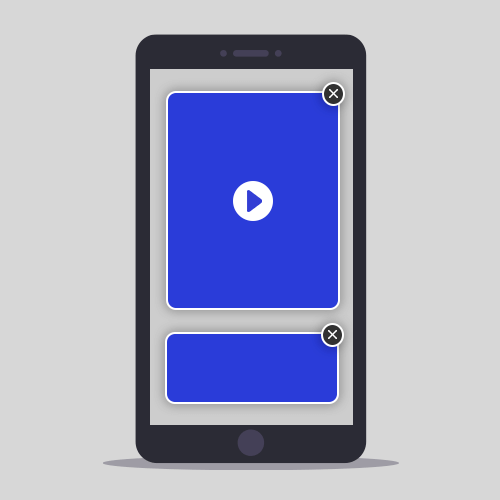
This is the most effective advertising model when we talk about in-app ad integration. Online users watch them in exchange for points, lives, or virtual goods. Through such an ad model, it is easy to make money, as an advertiser you are able to communicate brand messages effectively.
The biggest advantage of using this ad campaign is high retention rates, as users receive a reward for watching these ads. It works best for the gaming apps market, the gamer like free things, the effective cost per millie with this type of advertising is higher than for any other ad type.
Now, every app monetization model has some pros and cons, as the great philosopher once said everything has two sides good and bad, let’s have a look at the gist of this app monetization strategy.
Pros - It adds up to your app’s primary income through CTR
- In-app ads have a higher probability of reaching the target audience
- Ads help in measuring user interaction
- Video ads generate higher traffic than social media networking, web browsing or audio ads

Subscriptions
Subscriptions can be a quite useful monetization strategy. App publishers can choose to offer free content in their apps for a limited amount of time and then charge users for a subscription fee that will allow them to access full content without any restrictions.
The popular and common technique used by the majority of free app publishers is to offer a free trial period and then charge the subscription fee to those who wish to continue to access the app content.
This type of strategy is often used for cloud services, audio and video streaming, and online news services.
To ease the integration of this revenue model, Apple is paying extra attention and making significant changes in how app subscription models work. In the present model, Apple will maintain its current 70/30 revenue split for the first year of subscription. After one year, the new 85/15 revenue share will automatically be implemented.
This new format was made to encourage the app publishers to sell their apps for a recurring fee instead of a one-time cost. But despite this, only 5% of the most successful apps are using a subscription revenue model or developing subscription-based mobile apps, according to Sweet Pricing.
Before concluding this business model, let’s have a look at this strategy’s pros and cons.
Pros - It is an apt model for cloud services that provide audio & video content providers like Spotify.
- More engaged and serious audience to use the functionality of the app.
- It results in a more reliable income.
- Apple store rewards the app to keep the customers for a longer period of time.

Selling Merchandise
Another innovative approach is to sell merchandise in your free mobile apps.
Many e-commerce businesses build free versions to sell physical goods such as toys, shirts, shoes, etc. these physical products can be sold directly to the app or via email marketing.
To encourage app publishers to use this strategy, Amazon has started a service called Merch by Amazon that allows publishers to create their artwork, upload it to their platform and promote their products. It is a win-win strategy for the owners and app users.
To make things easier, Amazon even takes care of the payments and delivery of items.
Now, have a look at these pros and cons that will help you in deciding whether to select this monetization model for your free app idea.
Pros - Selling online allows you to reach more people anytime, anywhere.
- It is an additional convenience feature, enabling users to browse their inventory & order accordingly.
- The endless aisle where shoppers never have to leave empty-handed

In-App Purchases
In-app purchases are directly made from within the free mobile apps and are usually quite a simple process. They’re typically used to access special contents or features such as powerups, restrictive levels, or additional features.
In simple words, in-app purchases provide an ability to sell a variety of virtual items directly from the app. The best free game apps like Clash of Clans, Angry Birds, have enhanced their user experience by providing users with in-app purchases.
According to Forbes, apps with in-app purchases generate the highest revenue for their publishers. This monetization strategy is also expected to dominate in the years to come.
Generally, this model is used by game publishers, mostly because of the digital money. In fact, half of the games provide more than one game currency such as gems, coins, and gold. Such in-app purchases play a major role in app downloads.
Overall, this is an interesting model for converting non-paying app users into paying users without being too intrusive. Although, you’ve to keep users hooked in your free mobile apps so that they keep paying.
According to the survey by tech company Fyber, “Among ad agencies and brands, there are a number of brands, approximately 77%, which have asked their agencies to invest in the in-app purchases inventory.”
Well, both UK agencies and advertisers are now spending the majority of their advertising budgets on mobile. The reason for investing in in-app ads is that the format is more reliable than mobile browser ads. Moreover, improved engagement is another core reason behind in-app purchases.

Furthermore, according to the report from Business of Apps, “The formats playable ad formats, rewarded videos & opt-in are seen as the most effective in-app purchases method.”
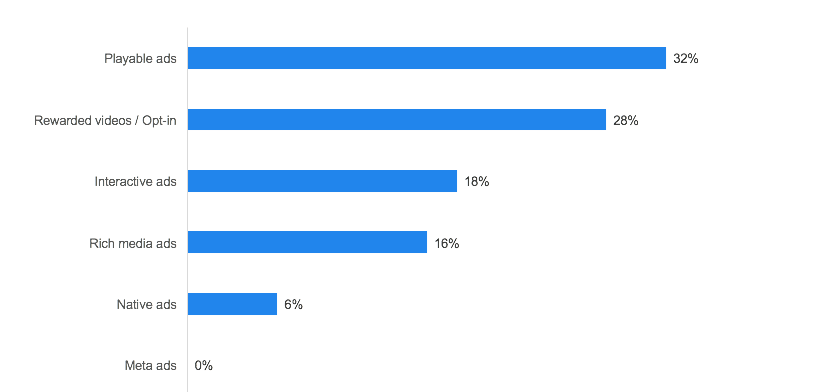
Before concluding this business model, let’s have a look at this monetization strategy’s pros and cons.
Pros - There is a good chance to obtain high profits from a low-monetization method
- This model is best for gaming apps as games provide more than one currency such as gems, coins, and gold.
- It is the key to provide more advanced services through your app
- Credit details are secured safely for in-app purchases

Thus apps also make money without ads, in-app purchases, and selling merchandise. Check out 7 more monetization tactics, namely
1. Sponsorship
2. Referral marketing
3. Collecting and selling data
4. Freemium upsell
5. Physical purchases
6. Transaction fees
7. Crowdfunding
Sponsorship
Sponsorship is one of the less commonly used monetization methods, but it can be still an interesting strategy.
In simple words, Sponsorship in your mobile applications can be a powerful app monetization strategy if the app publisher builds the right niche app for a targeted audience and launch it on behalf of another company.
Similar to websites, app publishers need to consider sponsors whose target audience is the same as the one being addressed by the app. Before building the app, creating a list of organizations and brands that could benefit from the partnership is a good starting point.
A good example of this how do free apps make money through sponsorship deals is Home Depot sponsorship on the Weather Channel App. the animated app background behind the temperature measurement is the advertisement placed by the sponsor to target homeowners interested in weatherproofing their houses.
Now, have a look at these pros and cons that will help you in deciding whether to select this app monetization model for your free app idea.
Pros - It involves offering advertising space within your app to brands with exclusive content or discounts.
- Brands can outstand their presence in the app and users get exposed to certain offers and discounts.
- Minimal disruption to user-experience

Referral Marketing
Referral marketing involves promoting a third-party product or service as a way to optimize revenue opportunities.
App publishers can promote or sell affiliates’ products or services based on the number of clicks or installs. For this, you can use pop-up ads to promote someone else’s app or advertise products.
There are different types of referral marketing models that publishers use in their development.
Cost per acquisition or Cost per action (CPA):
There is a number of affiliate networks from which you can find the one that suits your free mobile app. In this model, you can either promote other apps, advertise products with pop-ups, or promote apps through an in-app store and earn money.
Cost per click (CPC):
This type of revenue model is based on a number of clicks on an ad displayed. You can join the popular networks such as Adfonic or Google’s AdMob for this model. They both provide text and display advertisements which will help you to earn money for the app.
Cost per view (CPV):
This model involves charging based on the number of ad interactions or video views. Smartphone game development company BrightHouse successfully increased its app revenue by 130% through cost per view networks.
They used video as well as interstitial ads in their smartphone game to create natural breaks in between game sessions.
Cost per install (CPI):
Cost per install is a relatively new marketing mechanism and is the mobile equivalent to CPA (cost per acquisition) in the web marketing world.
Cost per install is exactly what it sounds like – you get paid for each install of the advertised app in your free app.
There is a number of platforms providing software to install into your app. The best example of this model is Chartboost and Playhaven. Both are third-party networks that have software that you install into your app.
The fee for this network ranges from $0.80-$3.00, and online affiliate networks have a range of campaigns for global traffic generation while promoting other apps, making it a lucrative market to play.
Now, have a look at these pros and cons and decide for yourself whether to go for this monetization model or not.
Pros - It is an apt way to promote the most loved or sold product in the app.
- It is the most trusted and influenced monetization model for apps
- Referred customers are both profitable and loyal in the long-term.

Collecting and Selling Data
As you know, apps collect a lot of users’ data, in terms of user behavior or other app usages. All these user behavioral data are desired by many researchers in different fields.
This means the app for free publishers can sell their users’ behavior data to these researchers and make a handsome amount of money. The data generally contains users’ email addresses, social media accounts, and personal preferences.
There are two ways to benefit from this model. You can either track what users do and sell data to outside companies and researchers, or you can use the raw data for your own purposes.
From a marketing point of view, companies want to pay for displaying ads to the most relevant audience. So if you can gather enough relevant data, then you can have a way to make a profit out of it.
Therefore, the below-given image is the quick look that will help you squeeze the most out of the monetization strategy:
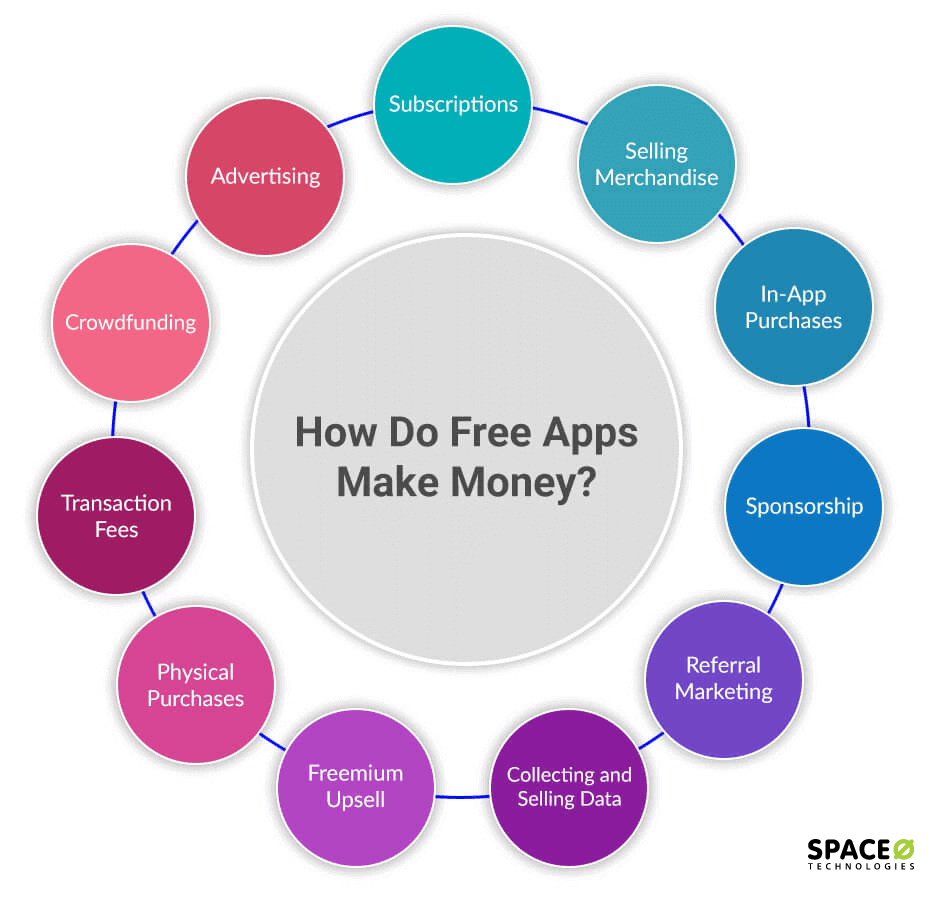
Before concluding this business model, let’s have a look at this monetization strategy’s pros and cons.
Pros - Through this model, you will easily avail of consumer segmentation and make the buying process quite easy.
- Such data is a helpful tool in identifying and listening to consumer voices and make them available to apt companies.
- It can result in genuine monetization app model.

Freemium Upsell
When it comes to talking about freemium upsell, freemium apps are available free of cost to download but contain paid or premium features. These paid and premium features can be accessed through in-app purchases.
In this type of freemium model apps, users download the app without paying any charge, and if they like the content of it, they can get full access to functionality by committing a purchase. Using this tactic, gaining lots of new users is easily possible because premium features are optional.
Moreover, this strategy is extremely common for education and health and sports application, allowing users to get premium features at a particular cost.
Now, have a look at these pros and cons that will help you in deciding whether to select this freemium model for your free app idea.
Pros - No intrusive ads
- This model is compatible with any other approaches
- It is a low maintenance app monetization tactic
- This model has wide reached as it is free for the users

Physical Purchases
There are many eCommerce businesses and startups that have started using free applications for selling their products or physical goods like mobile cases, t-shirts, toys, etc. via developed apps on the app store. Let’s take an example of one such free application, Angry Birds, that increased the profit from branded products.
Through this free gaming app, Rovio company sells approximately 1 million branded t-shirts, backpacks, and stickers every month. In fact, Amazon is offering a way to get revenue from merchandise by creating a Merch self-service program to sell custom branded t-shirts from their apps.
Before concluding this business model, let’s have a look at this monetization strategy’s pros and cons which will make your vision more clear while thinking about how do free apps make money.
Pros - This business model is flexible for every vertical.
- This can help marketers to make comfortable profits with the lowest amount of risk
- This model can also be adapted to include affiliate programs and partnerships that drive referral revenue

Transaction Fees
The best way to monetize your apps is transaction fees. It is the best way to make money from your apps on the app store. It is especially possible with those apps that provide a platform, where digital transactions occur on a regular basis.
Let’s take an example if your mobile app has an option for third parties to sell their products and those purchases can be carried out online, then you can charge transaction fees. You can charge a small fee for every single transaction that occurs on your app and makes a lot of money. This way, you can make your mobile apps to earn money without investing much money.
We have curated some pros and cons on transaction fees which will give you a clear idea about it’s loopholes.
Pros - It is an income generation in disguise
- This model promotes cashless transactions
- No user credibility is harmed

Crowdfunding
Another monetization way to make money from free apps is crowdfunding, which is new in the industry. In this method, startups and companies share their idea on platforms like Kickstarter, Patreon, Crowd Supply, Fundable, Indiegogo and Chuffed in search of donations to fund the development and promotion of the application.
According to Mobile Growth Stack reports, non-gaming mobile apps are highly preferable in crowdfunding. As of May 2017, there were approximately 138 non-gaming apps that known to raised funds between $10,000-$100,000 as compared to 29 mobile games that got a similar funding goal.
Before concluding this business model, let’s have a look at this monetization strategy’s pros and cons.
Pros - Access to cheap money
- Pre-funding your next product
- Easier investor relations

Not Sure How to Monetize App?
Want to validate your app idea? Want to get free consultation from an expert?
3 Tips for Choosing the Best App Monetization Methods
Keep the type of app in the center
Before deciding any of the monetization models, you need to understand the type of your app. What and how does your app solves a problem?
Once you have a clear idea about the purpose, you will be able to select the apt monetization method for your app on the app store. For example, subscription models for content and service apps. And it is not likely to work for single purpose apps, gaming apps, shopping apps.
Competitor analysis
The competitive analysis is not just for features, functionalities, and design of an app. With proper study of your alike competitors, you can easily find out the monetization business model for your app. Ask yourself certain questions like how competitors are earning money? How strong their monetization models are? Is there any loophole that can become an opportunity for you?
Know your target audience
To successfully earn online revenue through app monetization strategies, you need to study your target audience beforehand. Who are they? What they need? How much they are willing to pay? In short, users should know the real value to make purchases.
After going through all these how do you make money from free apps, you are nearly ready to develop your idea in an app. Our app developers have prepared an easy app cost calculator so that it becomes easy for you to have a rough estimation of your app development cost.
How Much Does it Cost to Build an App?
Are you wondering how to calculate app development cost?
Not to worry. We are at your rescue.
Apply this simple formula
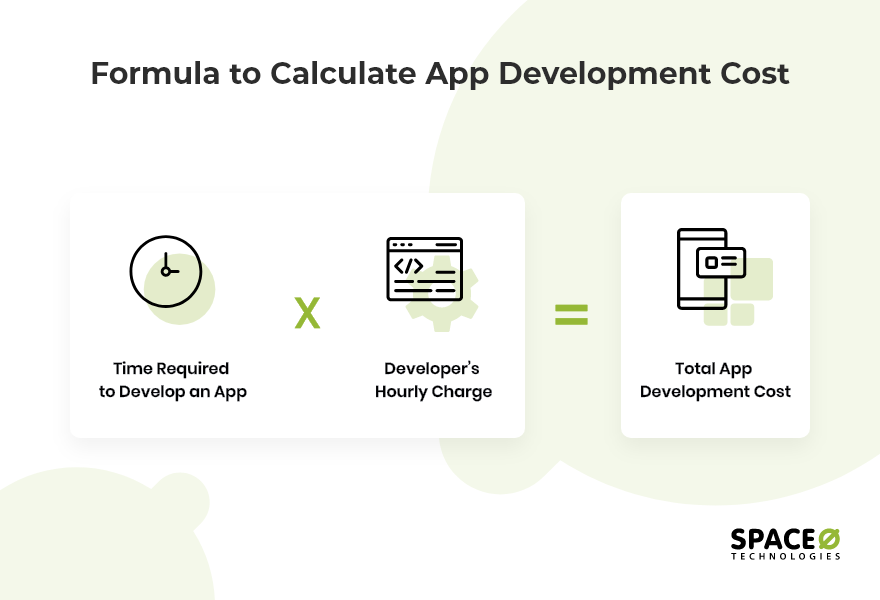
Let’s take a quick example that will explain to you how to calculate the app cost.
Development hours for user’s app: 300
Development hours for driver/ instructor/ delivery man app: 195
Total hours spend to make a mobile app: 495
Now, for professional mobile app development, of course, you will hire a professional app developers agency like us. Normally, we do charge approximately $30 for an hour.
Taking this cost into consideration let’s apply the formula, the result will be.
Estimated hours = 495
Hourly charge = $30
Total app development cost = $14,850 and €13500.43 for European countries.
The cost also varies as per your selected types of apps and their technology.
If you have calculated your app development cost, here is an insight into the mobile app revenue over the years. Have a look at the futuristic scope of the app world.
Let’s Talk About Future of Free Apps
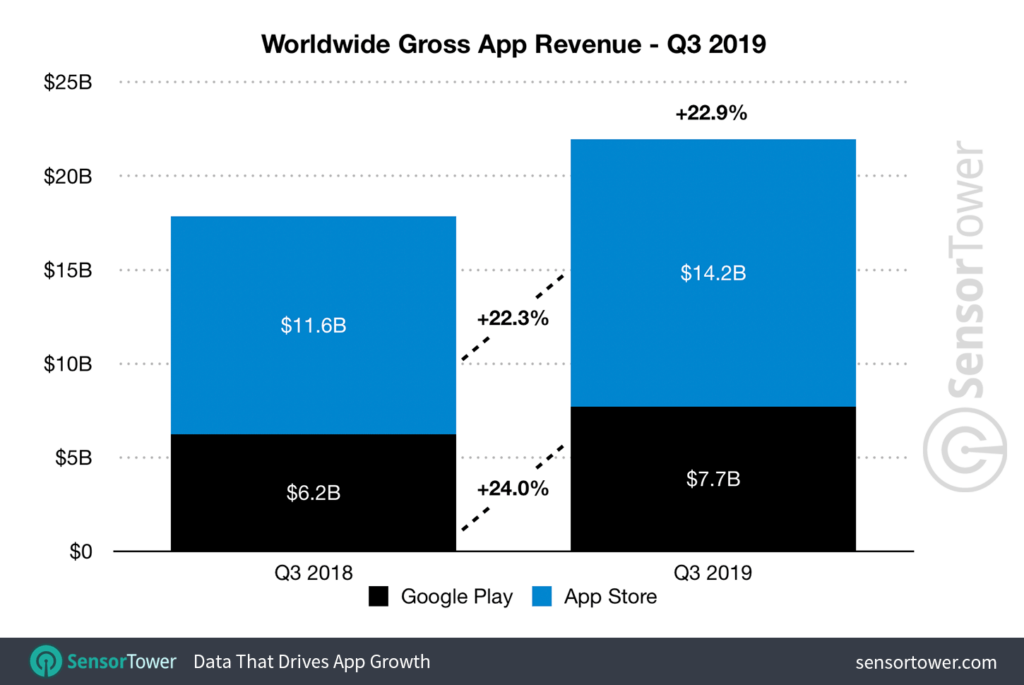
As you can see from the above-mentioned statistics of the respective app stores, the growth of the mobile app market isn’t stopping anytime soon. Despite increasing competition in the industry, publishers are also applying new monetization methods and creating more useful free apps for users.
None of the above-mentioned monetization options could be described as inefficient. In fact, app publishers have gained skills in using these models in particular cases.
For example, the subscription model works only for a certain niche but is the most profitable of all if deployed correctly.
Besides this, hybrid monetization models, such as in-app purchases and in-app ads, are clearly gaining popularity in the business world. Most app developers say that in-app advertising is set to be a key driver of overgrowth in upcoming years.
Only time can tell the real truth of how the mobile app market will develop. But for now, current market trends show that the market will continue to generate higher revenue in the foreseeable future.
FAQs
How does a free app make money without ads?
To create online revenue there are other ways than ads, paid installs, in-app purchases. There are some innovative strategies to monetize mobile apps.
- Expand to gaming
- Freemium app
- Subscription-based model
- Join an app referral program
- Social media integration for more users
Before you choose any of the monetization methods for your free app, think about the users. You must select a method that does not annoy them while functioning in the app and they retain the app for a longer time period.
Is it hard to make an app?
The steps of making an app consists of wire-framing, app design, and programming. If you hire an experienced and skilled mobile app development company like us then you will have a steady and concrete app development. It all depends on your app idea and its basic gist to the firm you are approaching for development.
How much money do apps make per download?
For a fact, an app does not get money from the downloads. At least not on the App Store or Google Play. Amazon underground is the only platform where you will get paid users using your app.
Apps can make money through many monetization methods, but there are 3 common ways
- Outright Sales (your paid app)
- In-app purchases (purchases made within your app)
- Advertising
How much money does a free app make from ads?
Most of the advertising networks follow the cost per click (CPC) model for the app. So whenever a user clicks on an ad, few pennies are added to your pocket. The average revenue per click is around $0.10 for banner ads. The minimum or optimum click-through ratio (CTR) for an app is around 1.5-2%. It also increases user engagement in the app.
Bottom Line
With so many app monetization models to make money with apps, it is important to note that each method has its own benefits and drawbacks to give while monetization of the app. However, trying out these tactics and analyzing what competitors are doing is a good starting point. Now, you might have got the answer to your questions like how much can you make from an app, how to make money with new app idea and how to make money off a free application or found different ways to make money from free apps.
So when start working with a reliable mobile app development firm, you should take the app structure and target audience into consideration before choosing the monetization strategy.
In case, if you still have any query or confusion regarding creating an app that makes money, like:
- How to monetize mobile apps?
- How to make money off an app?
- How to make money from an app idea?
- How to make money from iOS apps or Android apps?
- How do you create money-making apps in simple steps?
- How long does it take to make an app?
- The average cost of developing an app
Then get in touch with us through the contact us form. One of our sales representatives will revert to you as soon as possible and discuss such apps that make money and how it is possible. The consultation is completely free of cost.
This page was last edited on November 9th, 2020, at 3:33.
Author Bio

Jigar Mistry
Designation: Vice President (Technologies)
Jigar Mistry is Vice President (Technologies) at Space-O Technologies. He has 14+ years of experience in the web and mobile app development industry. He has expertise in different mobile app categories like health and fitness, eCommerce, and on-demand.

-
-